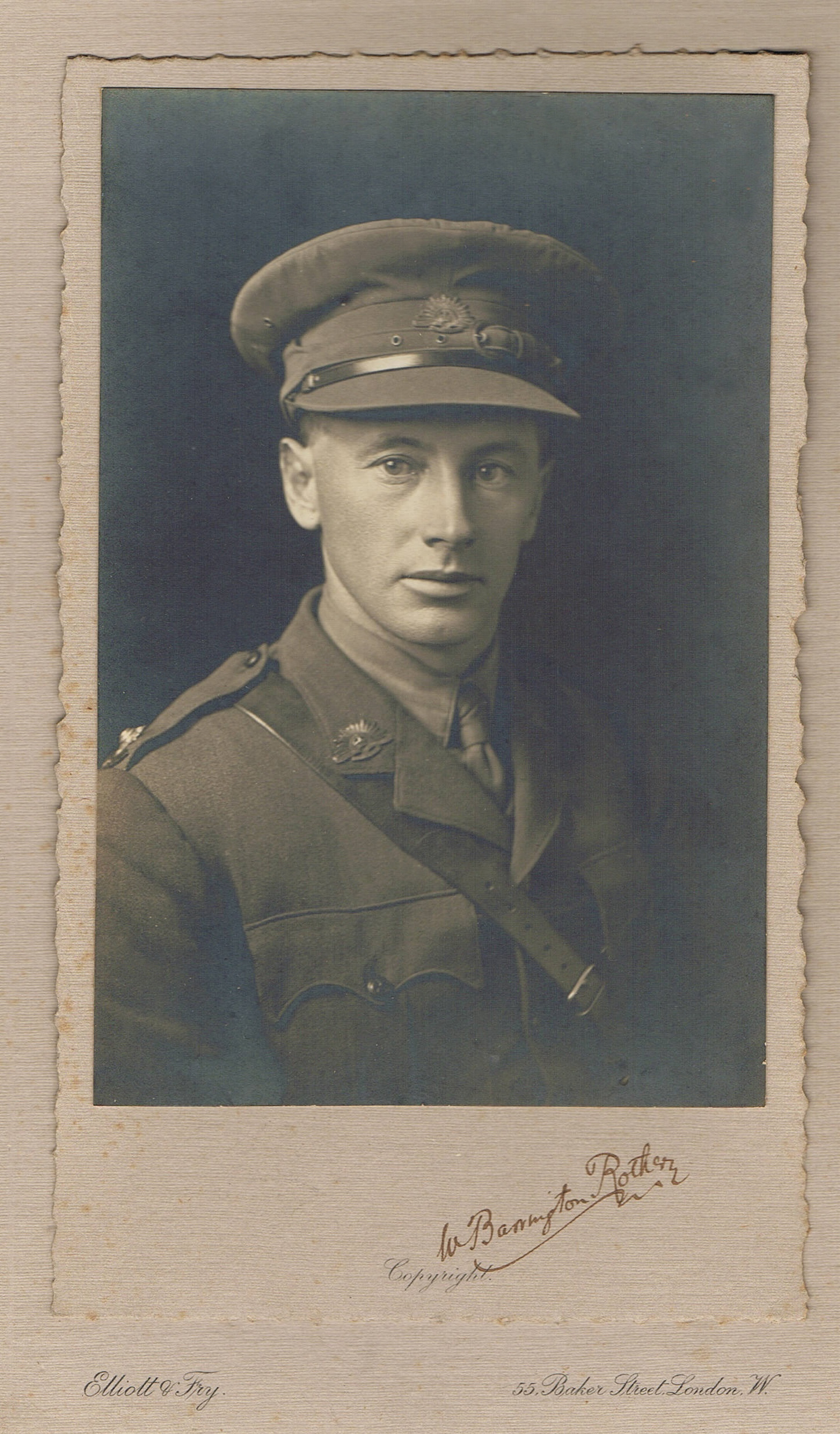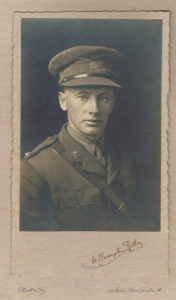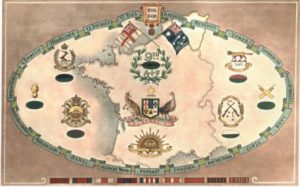William Barrington Rothery was born in the manse of St John’s Church, Kite Street, Orange, on 9 April 1883 to Barrington Rothery and Florence Theresa (nee Hosie). He was educated at Barker College near Hornsby and married Edith Ann Harrison on 18 September 1915 at St John’s Church, Parramatta, just over a month after he had enlisted with the AIF.
On 10 August 1915, William enlisted in the AIF. The location of his enlistment is not recorded although his application for a commission mentions him sitting a school at the Royal Agricultural Showground in Sydney. This is also likely to be the place where he enlisted. He was living at Quinton, Dundas, at the time. His job was listed as a Station Manager and Grazier.
William’s commission was formally approved and gazetted on 25 May 1916. He left Sydney with the 5th Reinforcements of the 34th Battalion on board SS Napier on 17 November 1916, one year and three months after he enlisted. The length of time between enlistment and embarkation is very unusual. Perhaps it was due to the fact that he applied for a commission and had to sit for some exams that delayed his departure. His application form shows that he sat for qualification for 2nd Lieutenant at the AIF School in Duntroon, between 22 March and 18 April 1916.
The 5th Reinforcements arrived in Devonport, England, on 29 January 1917 for further training before proceeding overseas to France. They marched into camp for the 9th Training Battalion two days later. On 8 February, William was admitted to the 3rd London General Hospital with fractured ribs and was discharged on 20 February. He was admitted to Fargo Hospital from 12 to 21 April with calluses on his heel.
William attended musketry school at Tidworth from 1 to 24 May 1917, attaining first class qualifications in musketry as well as Lewis Gun training. He returned to the 9th Training Battalion and remained with them until his departure for France on 24 August. He arrived in Le Havre on 26 August and was marched out to join his unit on 31 August.
On 2 September William joined the 34th Battalion, who were billeted in the village of Vaudringhem in the north of France. The 34th were “in training for new offensive in accordance with new formations laid down by GHQ for the attack on enemy’s new system of defence.” William was promoted to Lieutenant whilst in this location.
The battalion stayed in these billets until 26 September when they broke camp and set off for the front in Belgium. The first day saw them march from Vaudringhem to the village of Coubronne, a distance of 21 miles. Day two was a march of similar distance to the village of Godewaersvelde, just north of Hazebrouck on the French-Belgium border. The next day they marched eight miles to the village of Wirnnezeele. Here plans were made to enter the front line south of Zonnebeke.
Lieutenant Rothery was marching into a very hostile environment for his first engagement in the front line. The Battle of Menin Road Ridge had just claimed more than 5,000 Australian casualties, and the Battle of Polygon Wood almost 6,000.
The 34th Battalion’s diary for 1 October records:
Clear and bright. Aircraft very active from 9 to 11.30. The enemy heavily bombarded the 34th Battalion support line were fired on with unpleasant regularity … A cable burying party working in the vicinity of Potsdam were heavily strafed and 51 casualties resulted.
On 3 October the battalion was relieved by the 10th Brigade. The 34th made their way back to the ramparts of the walled city of Ypres for a rest. They had suffered 24 killed and 77 wounded.
The following day the battalion marched south to a tented camp. They stayed in various camps over the next few days, moving back to Ypres on 10 October in readiness to enter the frontline at Passchendaele. Heavy rain had been falling for four days straight and the battlefield was turning into a quagmire with mud knee deep and rain filling shell holes deep enough to drown in. The ground was slippery and perilous. Duckboards were used to try to save the men from sinking into the mud.
At 6pm on 11 October the battalion started their march forward to their “jumping off line” in front of the village of Passchendaele. The obstacles that faced them were tremendous given the conditions of the battlefield and the weather. The battalion diary best describes the events of the day:
During the assembly and right up to zero hour, the Battalion was subjected to heavy fire by 7.7s and 4.2 H.E. The greatest part of this fire appeared to come from S. and S.E. of PASSCHENDAELE, casualties were heavy, principally on the right flank near the cemetery.
At 5.25 am our barrage came down. It was very weak and in many cases it was difficult to determine which was our barrage and which was fire from the enemy. This made it difficult for the men to keep up with the barrage. The greatest obstacle met in the advance was the conditions of the ground, particularly on the left flank. There were many men lost altogether in the bog.
The pace of the advance was slowed up owing to the assistance it was necessary to give men who had sunk into shell holes and who could not extricate themselves without assistance.
The battalion sustained severe casualties during the advance: all officers had been either killed or wounded, the bulk of the organisation fell on the shoulders of the non-commissioned officers who did remarkably fine work.
It’s just as well William was a Transport Officer or he would have almost certainly become a casualty of this battle like his commissioned colleagues.
Over the next few days the exhausted battalion held their line but were constantly subjected to heavy shellfire, adding tremendously to their fatigue. At 6pm on the 14th they were relieved by the 46th Battalion and withdrew to the support lines.
For the next two months the 34th Battalion moved between the front line and various rest camps on the Western Front.
On 2 January 1918, the battalion moved to billets in the village of Meteren. Shortly thereafter William was admitted to the 14th General Hospital at Boulogne with a sore foot which was diagnosed as synovitis. He was discharged to duty on 16 January but was readmitted five days later. On 11 February William was examined by Major General Neville Howse VC, who issued the following report:
I have personally examined Lieut WB Rothery, 34th Battalion and found him suffering from an Osteoma on the Os Calcis. I do not consider an operation advisable nor justifiable.
To obtain a further opinion, I placed Lieut Rothery before the AIF consultants. In their opinion he is permanently unfit for General Service and unfit for Home Service.
Lieut Rothery will accordingly be recommended for return to Australia as an invalid.
William was transferred to England on 20 February to await a transport ship home. On 13 March he boarded the HMAT Durham Castle at Weymouth and arrived in Sydney on 13 May 1918. His appointment as an officer in the AIF was terminated on 16 July 1918.
William went on to live a long and happy life. He lived in many parts of New South Wales including Beecroft, Waitara, Epping, Parramatta and Woy Woy. William Barrington Rothery died on 21 February 1962 at the age of 78 years, in the War Veterans Hospital in Collaroy on Sydney’s northern beaches.
* Peter Benson, 2014



